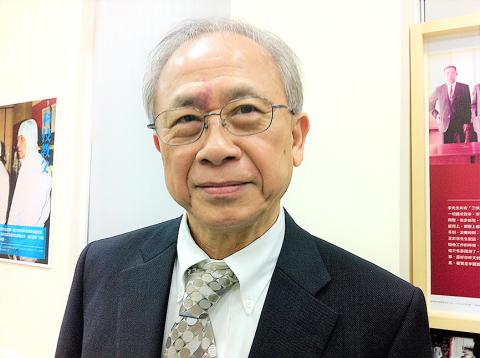Chung-Hua Institution for Economic Research (CIER, 中華經濟研究院) yesterday announced that its chairman, Hu Sheng-cheng (胡勝正), had died of pulmonary calcification on Tuesday evening at National Taiwan University Hospital.
The 77-year-old widely respected academic was survived by his wife and two sons.
Hu had been frail and was recently hospitalized for flu symptoms, his secretary said by telephone.

Photo: Wang Meng-lun, Taipei Times
The Taipei-based think tank is setting up a makeshift memorial hall for people to pay tribute to Hu from today, she said.
With a doctoral degree in economics from the University of Rochester in the US, Hu took the helm of CIER in 2016 at the invitation of President Tsai Ing-wen (蔡英文). He concurrently served as a standing board director at the central bank.
Tsai said Hu’s death was a great loss to the nation.
A native of Yilan, Hu taught at Purdue University for 28 years before returning home to teach at National Taiwan University in 1996. In 2000 he was elected a member of Academia Sinica, the nation’s top research institute.
Hu joined the government in 2001, first serving as minister without portfolio and later heading the Council for Economic Planning and Development (renamed the National Development Council, NDC) and the Financial Supervisory Commission.
Hu had called on the local industry to transform and upgrade, replacing the “Made in Taiwan” model with the “Served by Taiwan” orientation, the NDC said in a statement.
Hu also pushed for equitable distribution of the nation’s wealth and resources, as well as advocated the need for balanced development between rural and urban areas, the council said.
The central bank described Hu as a gentle man, who remained positive even as his health deteriorated after a serious gastrointestinal ailment in 2016.
He passed out during a meeting at the Presidential Office in April last year and was rushed to Mackay Memorial Hospital.
Academics across the political spectrum mourned his death, expressing their admiration for his academic prowess.
Hu gave up a comfortable life in the US and demonstrated great courage by joining the government in a time of tumult, Taiwan Institute of Economic Research (台經院) president Lin Chien-fu (林建甫) said.
As the head of CIER, Hu said the institute would strive for better quality and forward-looking research to help the government, industry and society.
He showed particular concern about the nation’s rapidly aging population, which he said merited serious attention from policymakers and the public so that they could better grasp the issue and make adjustments.

Shares in Taiwan closed at a new high yesterday, the first trading day of the new year, as contract chipmaker Taiwan Semiconductor Manufacturing Co (TSMC, 台積電) continued to break records amid an artificial intelligence (AI) boom, dealers said. The TAIEX closed up 386.21 points, or 1.33 percent, at 29,349.81, with turnover totaling NT$648.844 billion (US$20.65 billion). “Judging from a stronger Taiwan dollar against the US dollar, I think foreign institutional investors returned from the holidays and brought funds into the local market,” Concord Securities Co (康和證券) analyst Kerry Huang (黃志祺) said. “Foreign investors just rebuilt their positions with TSMC as their top target,

H200 CHIPS: A source said that Nvidia has asked the Taiwanese company to begin production of additional chips and work is expected to start in the second quarter Nvidia Corp is scrambling to meet demand for its H200 artificial intelligence (AI) chips from Chinese technology companies and has approached contract manufacturer Taiwan Semiconductor Manufacturing Co (TSMC, 台積電) to ramp up production, sources said. Chinese technology companies have placed orders for more than 2 million H200 chips for this year, while Nvidia holds just 700,000 units in stock, two of the people said. The exact additional volume Nvidia intends to order from TSMC remains unclear, they said. A third source said that Nvidia has asked TSMC to begin production of the additional chips and work is expected to start in the second

REVENUE PERFORMANCE: Cloud and network products, and electronic components saw strong increases, while smart consumer electronics and computing products fell Hon Hai Precision Industry Co (鴻海精密) yesterday posted 26.51 percent quarterly growth in revenue for last quarter to NT$2.6 trillion (US$82.44 billion), the strongest on record for the period and above expectations, but the company forecast a slight revenue dip this quarter due to seasonal factors. On an annual basis, revenue last quarter grew 22.07 percent, the company said. Analysts on average estimated about NT$2.4 trillion increase. Hon Hai, which assembles servers for Nvidia Corp and iPhones for Apple Inc, is expanding its capacity in the US, adding artificial intelligence (AI) server production in Wisconsin and Texas, where it operates established campuses. This

Garment maker Makalot Industrial Co (聚陽) yesterday reported lower-than-expected fourth-quarter revenue of NT$7.93 billion (US$251.44 million), down 9.48 percent from NT$8.76 billion a year earlier. On a quarterly basis, revenue fell 10.83 percent from NT$8.89 billion, company data showed. The figure was also lower than market expectations of NT$8.05 billion, according to data compiled by Yuanta Securities Investment and Consulting Co (元大投顧), which had projected NT$8.22 billion. Makalot’s revenue this quarter would likely increase by a mid-teens percentage as the industry is entering its high season, Yuanta said. Overall, Makalot’s revenue last year totaled NT$34.43 billion, down 3.08 percent from its record NT$35.52